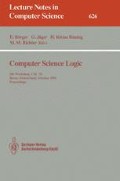Abstract
It is known, that over 1-dimensional strings, the expressive power of 2-way multihead (non) deterministic automata and (non) deterministic Transitive Closure formulas is (non) deterministic log space [Ib73, Im88]. However, the subset of formulas needed to simulate exactly k heads is unknown. It is also unknown if the automata and formulas have the same expressive power over more general structures such as multidimensional grids. We define a reduction from k-head automata to formulas of arity k, which works also for grids. The method used is a generalization of [K156], and the formulas obtained are a generalization of regular expressions to multihead automata and to grid languages. As simple applications, we use the reduction to show that the power of formulas of arity 1 over strings define (classical) regular languages, to give a simpler equivalent of the L=NL open problem, and to establish the equivalence of the automata and formulas over grids.
Preview
Unable to display preview. Download preview PDF.
References
Yaniv Bargury. The Hierarchy of Transitive Closure Master thesis, Department of Computer Science, Technion—Israel Institute of Technology, Haifa, (In preparation).
J. R. Büchi. Weak second-order arithmetic and finite automata Z. Math. Logik Grundlagen Math 6, 66–92, 1960.
Ariel Calò. The Expressive Power of Transitive Closure Master thesis, Department of Computer Science, Technion—Israel Institute of Technology, Haifa, 1990.
Ariel Calò and J.A. Makowsky, The expressive power of transitive closure, to appear in the proceedings of the Symposium on Logical Foundations of Computer Science ‘Logic at Tver '92', Lecture Notes in Computer Science, 1992.
W. Coy, Automata in Labyrinths Fundamentals of Computation Theory, LNCS 56, 65–71, 1977.
Elias Dahlhaus, Reduction to NP-complete problems by interpretations Logic and Machines Decision problems and Complexity, Lecture Notes in Computer Science, 171, 357–365, 1984.
J. E. Hopcroft and J. D. Ullman. Introduction to Automata Theory, Languages, and Computation. Addison Wesley, 1979.
Oscar. H. Ibarra. On Two-Way Multihead Machines. J. Comput. Sys. Sci. 7, 28–36, 1973.
Neil Immerman. Languages that Capture Complexity Classes. SIAM J. Comput., Vol. 16, No. 4, August 1987.
Neil Immerman. Nondeterministic Space is Closed Under Complementation. SIAM J. of Computation 17.5, 935–938, 1988.
K. Inoue and I. Takanami. A Survey of Two-Dimensional Automata Theory Machines, Languages and Complexity. Lecture Notes in Computer Science. 381, 72–91, 1988.
S. C. Kleene. Representation of events in nerve nets and finite automata Automata studies, 3–42, Princeton Univ. Press, 1956
Richard E. Ladner. Application of model theoretic games to discrete linear orders and finite automata. Information and Control 33, 281–303, 1977.
Burkhard Monien. Transformational Methods and their Application to Complexity Problems Acta Informatica 6, 95–108, 1976; Corrigenda, Acta Informatica 8, 383–384, 1977.
Wolfgang Thomas. Classifying Regular Events in Symbolic Logic. J. Comput. sys. sci. 25, 360–376, 1982.
Boris A. Trakhtenbrot. Finite automata and the logic of monadic predicates (in Russian.) Dokl. Akad. Nauk CCCP 140, 326–329, 1961.
Author information
Authors and Affiliations
Editor information
Rights and permissions
Copyright information
© 1992 Springer-Verlag Berlin Heidelberg
About this paper
Cite this paper
Bargury, Y., Makowsky, J. (1992). The expressive power of transitive closure and 2-way multihead automata. In: Börger, E., Jäger, G., Kleine Büning, H., Richter, M.M. (eds) Computer Science Logic. CSL 1991. Lecture Notes in Computer Science, vol 626. Springer, Berlin, Heidelberg. https://doi.org/10.1007/BFb0023754
Download citation
DOI: https://doi.org/10.1007/BFb0023754
Published:
Publisher Name: Springer, Berlin, Heidelberg
Print ISBN: 978-3-540-55789-0
Online ISBN: 978-3-540-47285-8
eBook Packages: Springer Book Archive

